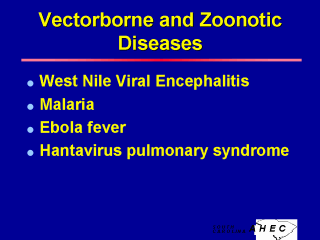| front |1 |2 |3 |4 |5 |6 |7 |8 |9 |10 |11 |12 |13 |14 |15 |16 |17 |18 |19 |20 |21 |22 |23 |24 |25 |26 |27 |28 |29 |30 |31 |32 |33 |34 |35 |review |
 |
- Cases of a West Nile-Like Viral Encephalitis first appeared in the US in 1999 in New York. This inflammation of the brain caused by viral and bacterial agents is transmitted by the bite of a mosquito infected with the West Nile virus. Mosquitoes become infected by feeding on birds infected with the virus and transmit the virus to humans and animals. The source of the US virus is unknown. Mortality rates range from 3% to 15%, with slightly higher rates among the elderly. - Malaria in humans is caused by one of four protozoan species that are transmitted by the bit of an infected female Anopheles mosquito. The estimated risk of a US traveler acquiring malaria varies markedly from area to area. From 1980 to 1992, 82 % of US malaria cases were acquired in Africa, 8% in Asia, and 5% in the Caribbean and South America. As mentioned previously, there is a world-wide problem with increasing resistance of malarial parasites to drug therapy. - Ebola virus is one of the deadliest viruses known and kills by causing high fever and severe bleeding (viral hemorrhagic fever). It emerges periodically from unknown, probably small animal, natural reservoirs, accidentally infects man, and causes dramatic self-terminating outbreaks. - Hantavirus is carried by rodents and in humans can cause severe pulmonary hemorrhage and death. It was first described during a 1993 outbreak in the southwestern US. USDHHS (1998), Preventing Emerging Infectious Diseases: A Strategy for the 21st Century, Atlanta: Centers for Disease Control and Prevention. USDHHS, Morbidity and Mortality Weekly Report, 47(RR-15), September 11, 1998, Atlanta: CDC. |
| front |1 |2 |3 |4 |5 |6 |7 |8 |9 |10 |11 |12 |13 |14 |15 |16 |17 |18 |19 |20 |21 |22 |23 |24 |25 |26 |27 |28 |29 |30 |31 |32 |33 |34 |35 |review |